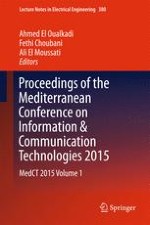This volume presents the first part of the proceedings of the Mediterranean Conference on Information & Communication Technologies (MedICT 2015), which was held at Saidia, Morocco during 7–9 May, 2015. MedICT provides an excellent international forum to the researchers and practitioners from both academia as well as industry to meet and share cutting-edge development. The conference has also a special focus on enabling technologies for societal challenges, and seeks to address multidisciplinary challenges in Information & Communication Technologies such as health, demographic change, wellbeing, security and sustainability issues.
The proceedings publish high quality papers which are closely related to the various theories, as well as emerging and practical applications of particular interest to the ICT community.
This first volume provides a compact yet broad view of recent developments in devices, technologies and processing, and covers recent research areas in the field including Microwave Devices and Printed Antennas, Advances in Optical and RF Devices and Applications, Signal Processing and Information Theory, Wireless and Optical Technologies and Techniques, Computer Vision, Optimization and Modeling in Wireless Communication Systems, Modeling, Identification and Biomedical Signal Processing, Photovoltaic Cell & Systems, RF Devices and Antennas for Wireless Applications, RFID, Ad Hoc and Networks Issues.
